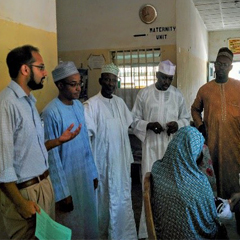Dr. Patil's lab is developing mobile phone based technology for neonatal jaundice screening, of particular utility for infants born in low-resource settings.

The first few weeks of life are a particularly fragile period for newborns, where illness can be particularly dangerous and result in death or lifelong disability. Chetan Patil and his team of researchers in Temple University's Optical Diagnostics Research Lab (ODRL) are working to help infants born in low-resource settings survive and thrive by developing a mobile phone based technology for neonatal jaundice screening.
Neonatal jaundice (NNJ) is a common condition worldwide that leads to delayed development, long-term neurosensory deficient, disability, and even death, while also being a significant source of co-morbidity in even more vulnerable pre-term and septic infants.
Worldwide, the burden of NNJ falls almost exclusively on low- and middle-income countries (LMIC's) because of dramatic disparities in the capacity to implement comprehensive systems for screening and treatment. Part of the challenge? Many infants are born outside of high-level facilities, and only have interactions with community health workers poorly equipped to perform screening.
The mobile-phone based transcutaneous bilirubinometer (phoneTcB) under development in Dr. Patil's lab is a low-cost, passive, and widely-distributable attachment snapped over a mobile phone's camera and flash.
The approach is similar to the transcutaneous bilirubinometer, a non-invasive optical device used in US hospitals for nearly 30 years to screen for neonatal jaundice. In both techniques, diffuse reflectance is used to quantify the "yellowing" seen in jaundiced infants skin, and produce measurements that correlate with serum bilirubin levels. In the phoneTcB, the snap-on adaptor filters and directs light to and from the skin, and as a result can be easily distributed as a mobile phone accessory to community health workers in LMIC's, where adoption of mobile technology in the last 10 years has been explosive.
The communication capacity of the phone is also central to approaches potential. Community health workers can communicate directly with regional care centers to coordinate treatment of infants identified as at risk.
Mobile-phone based techniques for screening and diagnosis represent an exciting opportunity for improving the standard-of-care in remote and low-income areas. In the case of neonatal jaundice, improved standards for screening coupled with increasing accessibility to treatment can ultimately facilitate reduced morbidity rates for afflicted children, and allow them to lead healthy, productive lives.
A significant challenge met during development was accommodating the simplified optical technique for accuracy in dark skinned infants, which was accomplished through model driven optical design. The basic feasibility of the approach has been demonstrated in pilot clinical study, and is now being further validated in a larger scale clinical study being conducted with collaborators at Vanderbilt University Children's Hospital in Nashville, TN and the Amino Kano Teaching Hospital in Kano, Nigeria.

